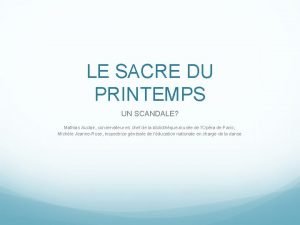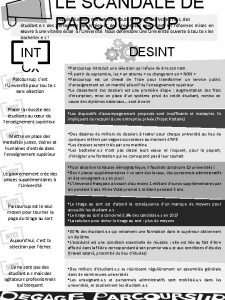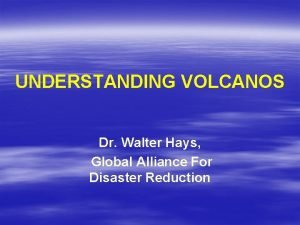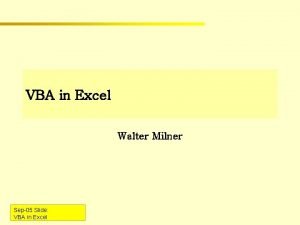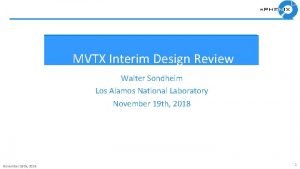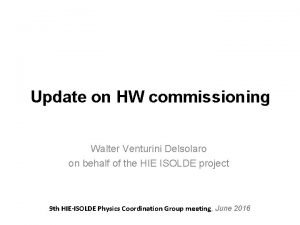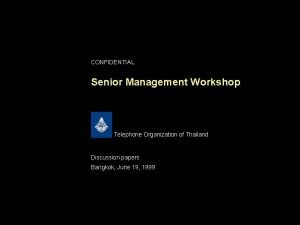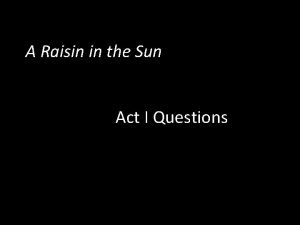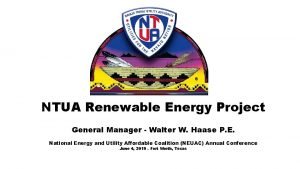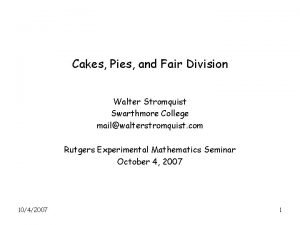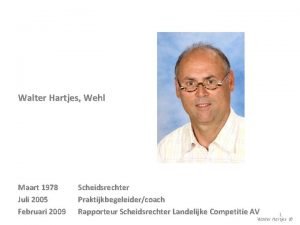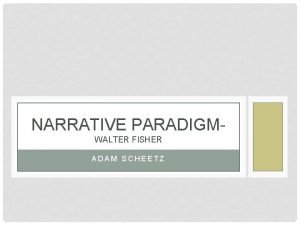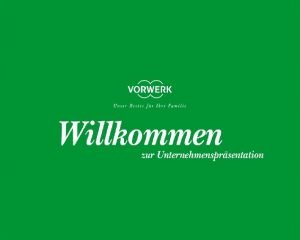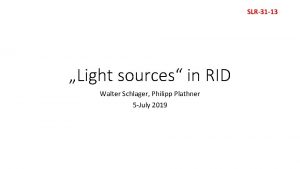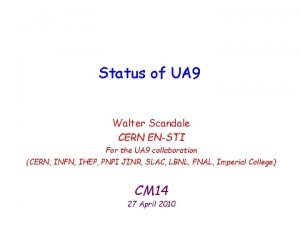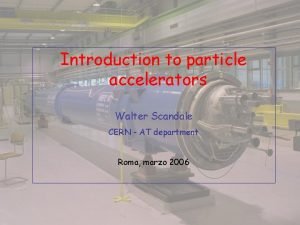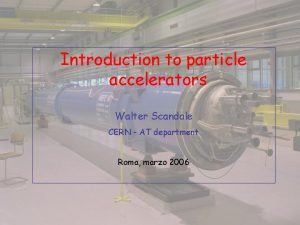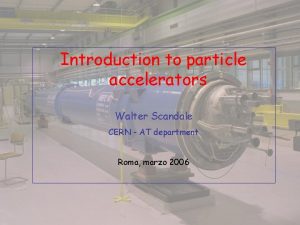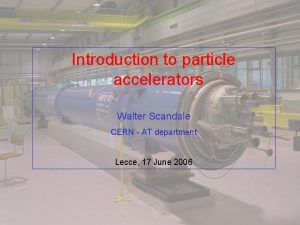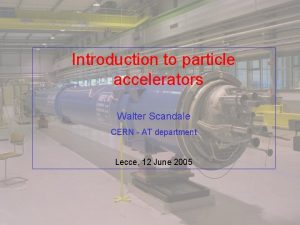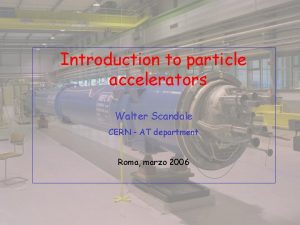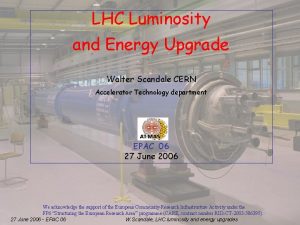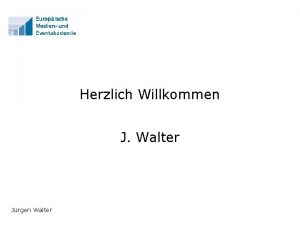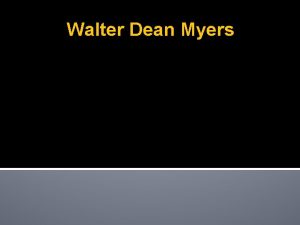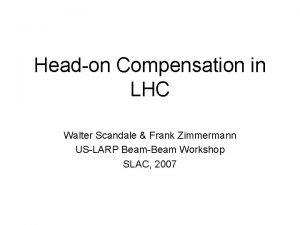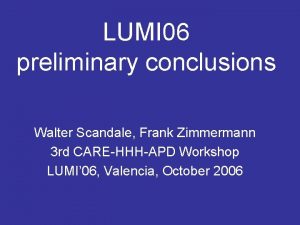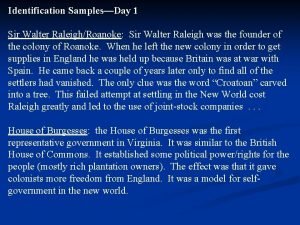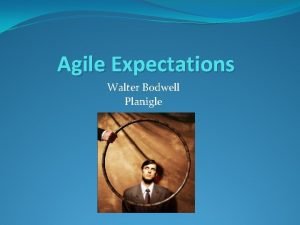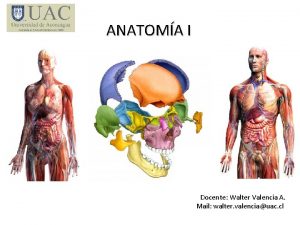Status of UA 9 Walter Scandale CERN CC


























- Slides: 26

Status of UA 9 Walter Scandale CERN CC 09 5 th workshop on crystal channeling 24 -27 March 2009 W. Scandale 1

Outlook u The crystal collimation concept u Lessons from H 8 RD 22 u The UA 9 layout u What is already installed. u Plans u Conclusions W. Scandale 2

Two stage collimation in a circular collider How it works ? Beam Core t t r 1 Secondary halo p p Primary collimator (scatterer) Primary halo (p) < x’ 2>~ L e p Shower r 2 t Short scatterer deflects the primary halo (ap. r 1=N 1√βTWISSε) Long collimator intercepts the secondary halo (ap. r 2=N 2√βTWISSε) halo particles captured through amplitude increase via multiple scattering and multiturn effect. Secondary collimator (massive absorber) W. Scandale 3

Crystal collimation E. Tsyganov & A. Taratin (1991) Beam Core Beam propagation Primary halo (p) Crystal p Absorber t Coherent deviation of the primary halo t Larger collimation efficiency t Reduced tertiary halo W. Scandale 4

Particle-crystal interaction Possible processes: t multiple scattering t channeling t volume capture t de-channeling t volume reflection Volume reflection Prediction in 1985 -’ 87 by A. M. Taratin and S. A. Vorobiev, U d First observation 2006 (IHEP - PNPI - CERN) W. Scandale 5

Angular beam profile as a function of the crystal orientation Angular profile (µrad) 9 mm long Si-crystal deflecting 400 Ge. V protons W. Scandale et al. PRL 98, 154801 (2007) The angular profile is the change of beam direction induced by the crystal 5 1 1 The rotation angle is the angle of the crystal respect to beam direction The particle density decreases from red to blue (peak efficiency) 3 4 1 - “amorphous” orientation 2 Rotation angle (µrad) 2 - channeling (50 %) 3 - de-channeling (1 %) 4 - volume capture (2 %) 5 - volume reflection (98 %) W. Scandale 6

UA 9 The underground experiment in the SPS Approved by the CERN Research Board of the 3 Sept 2008 Goals: u Demonstrate loss localization u Measure channeling and collimation efficiency u Measure the single particle dynamics (later ? ) CERN INFN PNPI L TA IHEP JINR SLAC FNAL LBNL

UA 9 layout Installed tank IHEP tank RP 1 RP 2 Installed TAL (tungsten) 600 x 30 mm 3

RD 22 tank

RD 22 tank

RD 22 goniometer

RD 22 tank with goniometers and thin target

crystals

Crystal alignment table

Multi Crystal cables Quasi mosaic crystal Quartz Cerencov detector Multi Crystal cables 30 x 30 mm 2 Horiz. scraper 1 mm W Single strip crystal Multi Crystal cables Scintillating counter Laser table for crystal alignment Scintillating counter Layout of the RD 22 tank G E M Beam axis

TAL (secondary collimator)

TAL (secondary collimator)

RP 1 (the CERN roman pot)

RP 1 (the CERN roman pot) RP 2

Beam loss and scintillator counters C 1 C 2 BLM BLM C 3 C 4

The SPS beam • We selected two energies of interest: – 120 Ge. V, as for the RD 22 experiments (reference data in the literature); – 270 Ge. V, as for other planned experiment in the SPS (faster setting-up) High energy unbunched RF Voltage [MV] 1. 5 0 1. 5 Momentum P [Ge. V/c] 270 120 Tune Qx 26. 13 Tune Qy 26. 18 Tune Qs 0. 0021 0 0. 004 1. 5 transverse radius (RMS) [mm] 0. 67 1 1 momentum spread (RMS) p/p 2 to 3 10 -4 4 10 -4 Longitudinal emittance [e. V-s] 0. 4 normalized emittance (at 1 ) [mm mrad] alternative tunes are those selected in RD 22 (Qx=26. 62, Qy=26. 58).

The SPS beam • Intensity a few 1011 up to a few 1012 circulating particles. • Beam either unbunched or bunched in a few tens of bunches. • Beam lifetime larger than 80 h, determined by the SPS vacuum. • A halo flux of a few 102 to a few 104 particles per turn, which can be investigated with the detectors in the roman pots • • evenly distributed along the revolution period (unbunched beam); • or synchronous to the bunch structure (bunched beam). Larger fluxes up to a few 105 particles per turn, which should be studied using only the beam loss monitors. Beam footprint in the crystal

Deflected beam QF 518 QD 519 QF 520 Particle trajectory with α=150 μrad taratin

Expected efficiency for α=150 rad position angle TAL hit Probability to hit the TAL Optimal orientation for channeling VR (- ) Probability to hit the TAL and RP 2 amorphous orientation Probability to hit the TAL, PR 1 and RP 2

Plans for 2009 UA 9 • First run: June 09 • Loss localization experiment by Sept 09 • Efficiency measurement by Nov 09

Conclusion t Infrastructure ready (cables, mechanics, beam loss monitors, RF noise, Beam intensity monitors) t Basic hardware installed (Tank, two gonioneters, two crystals, TAL) t Detectors in progress q Already installed: 1 cerencov q To be installed this week: 6 scintillators, 3 GEM, 1 si-strip, 3 BLM q To be installed possibly in May: 1 cerencov, 2 scintillators, a fibrometer, more si-strip UA 9 ready to start crystal collimation tests in June 09 W. Scandale 26
 Le sacre du printemps scandale
Le sacre du printemps scandale Parcoursup scandale
Parcoursup scandale Cern service desk
Cern service desk Walter atzori
Walter atzori Walter infant school
Walter infant school Daitim
Daitim Walter hays aa
Walter hays aa Exel walter
Exel walter Walter christaller model
Walter christaller model Walter weith
Walter weith Walter duggan stfx
Walter duggan stfx Sondheim
Sondheim Walter venturini
Walter venturini Walter elias disney childhood
Walter elias disney childhood Walter wintersteller
Walter wintersteller Walter duranty pulitzer
Walter duranty pulitzer A raisin in the sun questions
A raisin in the sun questions Ntua walter haase
Ntua walter haase Walter stromquist
Walter stromquist Walter hartjes
Walter hartjes Walter wodchis
Walter wodchis Walter fisher's narrative paradigm
Walter fisher's narrative paradigm What is the treasure of lemon brown about
What is the treasure of lemon brown about Walter cunningham personality
Walter cunningham personality Vorwerk niederlassungen
Vorwerk niederlassungen Walter e smithe brothers
Walter e smithe brothers Walter schlager
Walter schlager
